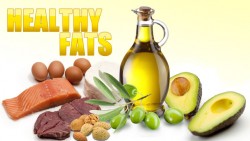 These days fat in food can get a bad rap, but fat is also important in that it provides energy and aids in growth and development. The key is to focus on the good fats (monounsaturated and polyunsaturated) and eliminate the bad fats (saturated and trans). Knowing which fats can be bad or good can be confusing.
These days fat in food can get a bad rap, but fat is also important in that it provides energy and aids in growth and development. The key is to focus on the good fats (monounsaturated and polyunsaturated) and eliminate the bad fats (saturated and trans). Knowing which fats can be bad or good can be confusing.
Which fats are good and which are bad?
An easy way to remember which fats are good and which are bad is pretty simple. If it walked before it reached your plate, it is probably full of saturated fat (red meat, bacon, dark meat chicken). If it swam before it hit your plate, you are probably getting some good polyunsaturated fats. Another clue to avoid the fat is if it is solid at room temperature. If the fat is liquid at room temperature, it is probably a good fat.
All fat – good or bad- has about nine calories per gram. So while eating a salmon filet may be good for your heart and a cheeseburger may be bad, either one will pack on the kilos if you eat too much. If you are eating 2,000 calories a day, 30% of that should come from good fats. Experts recommend you totally cut trans fats from your diet.
How can we add more good fats into your diet?
Good fats (polyunsaturated) include fish, walnuts and canola oil. Monounsaturated fats include olive oil, peanut oil, almonds and avocados. These foods can help lower cholesterol levels and prevent a variety of chronic diseases ranging from cancer to a stroke. Good fats help to lower your risk of heart disease because they reduce the LDL (bad) cholesterol levels in the blood. Omega-3s are a very healthy polyunsaturated fat that can help to prevent irregular heartbeats, reduce plaque buildup in the arteries and keep blood sugar levels in check (all of these help reduce the risk of heart disease).
Omega-3 and Omega-6 fatty acids are polyunsaturated fats which are essential because the body cannot make them. You have to get these fats from foods and the best sources come from fish. Incorporating fish as part of a heart healthy diet can slash your risk of dying from heart disease. The best sources for Omegas are fatty fish like salmon, mackerel and sardines. If you don’t like fish, many foods such as eggs to orange juice are now being fortified with Omega-3s. Canola, walnuts, and flaxseed contain Omega-3s in their oils in the form of alpha-linolenic acid (AHA).
Saturated and trans fat
Bad fats like saturated fats have long been known to clog arteries and increase the risk of diseases ranging from cancer to diabetes. Saturated fat is in most animal-based foods (fatty beef, pork, lamb, butter and cream). However, not all saturated fats walk. There are plant-based versions of saturated fat in processed foods and snacks. Oils like palm kernel, palm, cottonseed and coconut oil are on the list. They all contain saturated fat.
The ugly news about trans fats is that they originally started out pretty innocent. Scientists were looking for an alternative to saturated fat that would have a similar flavor, texture and appearance. They took healthy oils and made them solid through a process called hydrogenation. Hydrogenation gave us crisp french fries, perfect donuts and flaky piecrusts. But this created a trans fat that has an even worse cardiovascular impact than butter.
When you read the labels on packaged foods such as cookies, crackers, cakes, cereals, soups and salad dressings, look for trans fats that can be identified by the words “partially hydrogenated” and “hydrogenated” in the ingredient list. You will find that even products that are labeled “trans-fat-free” still contain trans fat if the ingredient list includes the word hydrogenated.
This is the good, the bad and the ugly about the fats in your foods.
